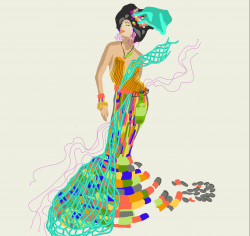There are few things more difficult to talk about than rape. And there are even fewer more difficult to depict on screen.
Of the films that approach the topic of sexual violence, some merely allude to it, others imply it, and a select few actually show it on screen.
Gone with the Wind remains well-known for its depiction of marital rape. Rhett Butler and Scarlett O’Hara, portrayed by Clark Gable and Vivien Leigh, respectively, enact a difficult scene in the second half of the film. Butler forces himself upon O’Hara—his wife—and carries her upstairs. The rest is left to the viewers’ imagination. The next scene is of O’Hara in bed, with a smile on her face. Butler offers his apologies and a divorce, but she refuses. Being a film from the 1930s, it’s difficult to imagine Gone with the Wind taking a more progressive position.
In 1971, Stanley Kubrick undertook portraying a more violent rape depiction with his adaptation of Anthony Burgess’ A Clockwork Orange. The story isn’t easy to digest: a group of reckless teenagers torture people to death for their own sadistic pleasure. Minutes into the film, Alex DeLarge and the rest of the droogs break into a couple’s home and beat them senseless. DeLarge proceeds to cut the wife’s clothing off as she is held down by one of his buddies. He rapes her on screen in front of her nearly unconscious husband. Kubrick didn’t shy away from disturbing depictions of pain, elucidating a visceral response in the viewer. His movies use this shock factor as their method of approaching the violence rampant in our society.
Quentin Tarantino’s Pulp Fiction, released in 1994, was similarly explicit. Boxer Butch Coolidge (Bruce Willis) nearly escapes mobster Marsellus Wallace (Ving Rhames), but runs into him after returning to salvage an irreplaceable family watch. Their chase leads them to a pawn shop and takes a turn for the worse: both men end up tied up. One thing leads to another, as Coolidge escapes and Wallace is left to be raped by the pawn shop’s security guard as the owner watches. Ultimately, Coolidge kills the owner and lets Wallace shoot the guard in the crotch. This rape doesn’t have the same haunting effect produced by A Clockwork Orange. The scene shows rape as revenge, pursuing a bigger impact at the expense of commentary on the vulgarity of sexual violence. This use of rape normalizes it as an acceptable, if twisted, form of retaliation.
Perhaps film’s most explicit depiction of rape was in David Fincher’s 2011 adaptation of The Girl with the Dragon Tattoo. Lisbeth Salander (Rooney Mara) has to deal with appointed guardians to get money. Her guardian is manipulative and aggressive, raping her before giving the allowance. Salander decides to fight back. In their next meeting, she tases him and rapes him with a dildo. Having recorded their previous encounter, she shows him her prepared blackmail and then tattoos the words “I am a rapist pig” on his chest. The triumph seems damaged because Salander uses rape to combat rape. The reality is that most victims won’t have the desire to rape their rapists, knowing the damage and pain inflicted by this atrocious act.
Maleficent unexpectedly strikes a balance. Using the metaphor of stripping the protagonist’s wings to represent rape, the 2014 Disney film starring Angelina Jolie presents a narrative that is watchable and empowering. A young Maleficent gets drugged by a person she trusts who goes on to cut off her wings. She becomes more cold and angry, trying to move on from a terrorizing experience.
Though the film overall was a disappointment, it was successful in euphemistically addressing the pain inflicted by rape. There doesn’t need to be explicit rape to make a point. Shock value isn’t always the answer.
Rape will never be easy to show in film. In an ideal world, its not something we would ever have to depict. We have, at least, moved beyond its romanticization and employment for entertainment to a nuanced discussion of the pain and devastation that it causes.




